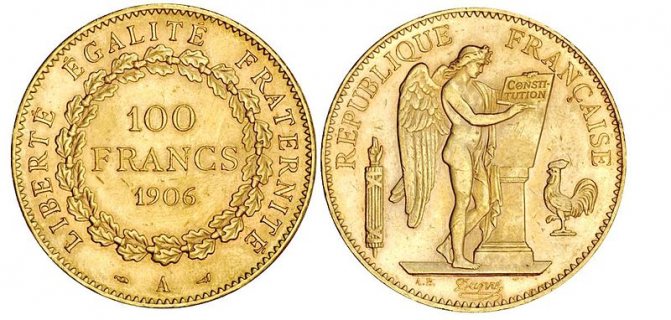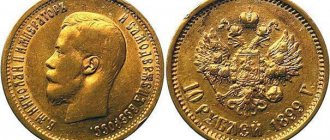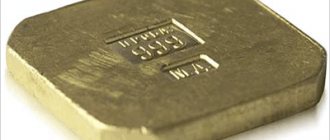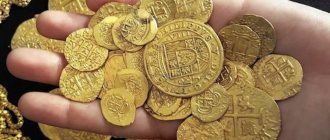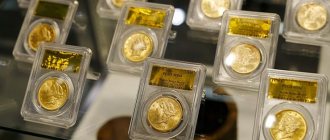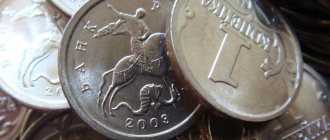Russian gold coins are not only beautiful products made of precious metal, but also things that have historical and artistic value. Gold coins were at one time even used in everyday life at face value, for example, in Tsarist Russia. Well, now coins made of precious metal can only be found as part of collections.
Russian gold coins
The Birth of Precious Coins
The famous ancient Greek historian Herodotus wrote in one of his treatises that the first gold coin was minted in the ancient state of Lydia, located in Asia. For a long time, the words of the learned man were questioned, since there was information that gold coins were produced in ancient times in China and in some ancient cities. But in the end, modern researchers were able to accurately establish that Herodotus was indeed right, and the history of ancient gold money began in Lydia in the 680s BC. But they were not made from pure gold, but from a natural alloy called electrum. This is a natural compound of gold and silver. This precious alloy was found in the beds of mountain streams flowing through the territory of Lydia.
The very first electrum coins bore little resemblance to the gold money we are accustomed to. They were made using a very simple method. The electrum was heated, making it softer, placed on a special plate and processed on top for a long time with a hammer. As a result, a certain image was knocked out on one side of the resulting flat piece. Only on this basis could such a product be called a coin, since they did not have other characteristics, such as uniform size, weight and purity of the precious metal. After a while, the Lydian king Aliattes, who reigned from 610 to 561 BC, ordered the establishment of a single weight of ancient electrum money. From then on, each such money had to weigh exactly the same as 168 grains of wheat weigh.
With the development of the craft of Lydian craftsmen, coins began to be minted in a certain size, as well as with a design on the reverse. They depicted a lion's head, which was a symbol of the Mermnad dynasty that ruled in Lydia.
And already under the king Croesus, who ruled from 560 to 546 BC, the standard for metal purity was established. The money was supposed to be 98% pure gold. The common saying “Rich as Croesus” can serve as indirect evidence of the introduction of the gold standard. Since then, the history of ancient gold coins has been chronicled.
The appearance of the coins has become more detailed. The obverse depicted a lion's head with an open mouth, facing to the right. A small star shone above her, symbolizing the sun. The reverse had two depressed squares. This coin design has been preserved from previous years, but under Croesus the quality
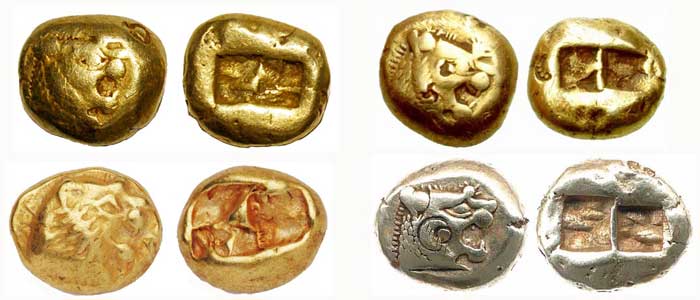
The value of these ancient gold coins was very high. An average resident of Lydia could survive on one coin for a whole month. That’s why they were not used to buy goods in markets. They were needed to perform several functions:
- payment of taxes to the royal treasury;
- payments to hired soldiers;
- payments to court servants;
- conducting wedding ceremonies;
- making sacrifices to deities.
They were also given to guests as a sign of hospitality, according to an ancient Lydian custom.
Best Coins for Investment
If you want to invest in banknotes made of precious metals, you need to understand that they are issued in two types - investment and commemorative.
The first is a piece of precious metal of a certain mass, enclosed in the form of a coin. Such specimens are produced in large quantities and have no numismatic value.
The latter are minted for anniversaries and memorable dates. They can be produced in quantities from hundreds to several thousand copies. Their price is determined by their demand among collectors, but, as a rule, it is higher than that of investment pieces of the same weight. Investments in commemorative coins do not guarantee a constant increase in value, but with a successful combination of circumstances, they can bring good income.
The main indicator that determines the profitability of an investment is the difference between the purchase and sale prices - the spread.
The victorious path of gold coins around the world
It was the gold coins that King Croesus brought as a gift to the temple at Delphi when he went to this Greek city to receive a prediction from the Delphic oracle. According to legend, Croesus donated a lot of money to find out whether his military campaign against the Persian kingdom would be successful. The oracle predicted his victory. And Croesus, without wasting any time, invaded the neighboring lands. But instead of victory, he led his state to destruction. The Persian king Cyrus not only repelled the attack, but also completely destroyed Lydia. This was in 546 BC. And the history of gold money received a new twist, as the Persians captured the mint in Lydia and learned the technology for issuing coins. The process of minting money in the Persian kingdom changed slightly, as copper was added to gold to increase its strength.
In the 4th century BC, the Persian kingdom fell under the onslaught of the army of Alexander the Great, who completely destroyed the state’s gold treasuries, seizing about four thousand tons of pure gold. During the reign of the great conqueror, throughout the vast territory of his empire, gold money with his profile was the most reliable. The weight of one such coin exceeded 7.2 grams. Alexander the Great set himself the goal of ensuring that in all cities of his empire all financial payments were made using the same coins - and trade between different territories was carried out freely. Only during the life of Alexander the Great, 26 mints operated on the territory of his empire, the number of which only increased after the death of the conqueror. In the third century BC, the minting of gold coins came to the Italian lands; the production of money from gold began in Rome.
We owe the very name “coin” to ancient Rome, since the first place where they began to produce gold money was the territory of the courtyard at the temple of the goddess Juno-Coin. People began to call the new money by this name.
The massive circulation of gold coins reached our lands much later than Western European countries. Scientists have found that the saint of Kievan Rus, Prince Vladimir the Great, began issuing the first gold and silver money of his own in the 10th century. Before that, people paid here with silver bars or Roman denarii brought from other states. The first Russian gold coin was called “zlatnik”. It weighed about four grams. It was thanks to the zlatnik that a new unit of weight appeared in Rus'. It was called a spool and corresponded to a weight of 4.266 grams. Only eleven of the first gold coins of Kievan Rus have survived to this day.
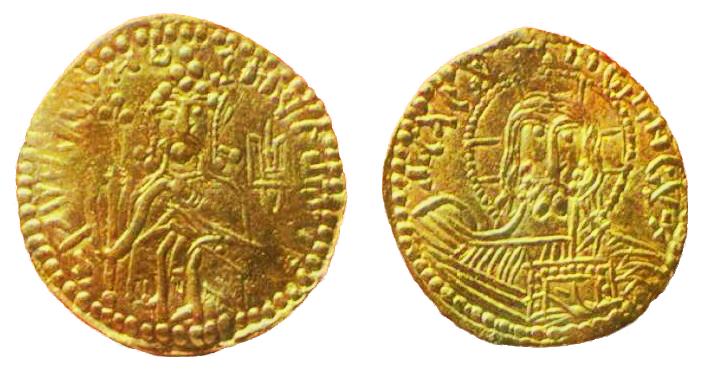
Collectible numismatic items
There are also numismatic coins. This is the third group that has a limited number of fans. Such coins are issued solely for aesthetic pleasure. Collectors buy coins to collect at home and organize an exhibition or simply enjoy the presence of these things.
The coins are really very beautiful. They are often released in series and in honor of some event. Therefore, the Russian gold coin is called “memorable”. For example, in the Russian Federation the most popular copies are:
- series with Olympic sports;
- series with zodiac signs;
- memorable dates in history, Russia at UNESCO.
But it should be remembered that numismatic coins are different from investment coins. They are not purchased to invest money in gold, and the bank will not buy such things back from the collector.
Therefore, before choosing a coin, you should decide on the purpose of purchasing it, if you are not a collector. As an aesthetic option, you can also consider bimetallic specimens, which are also manufactured by the Bank of Russia. Russian coins, in addition to investing money, can be an excellent gift. Specific copies should be considered for purchase only in banks or at serious auctions, while keeping the transaction documents. You also need to observe the correct storage conditions and care for the product.
Gold money of the Russian Empire and the USSR
In Russia, various coins, including gold ones, have been in circulation for several centuries. But it was only during the reign of Peter the Great that a monetary reform was carried out, which streamlined this process. In 1701, “chervonets” were launched into mass circulation, becoming the first regular gold coins in Russia. Their weight reached 3.47 grams, and their fineness was 986. At first, only 118 pieces were issued, but later the amount of gold money quickly increased.
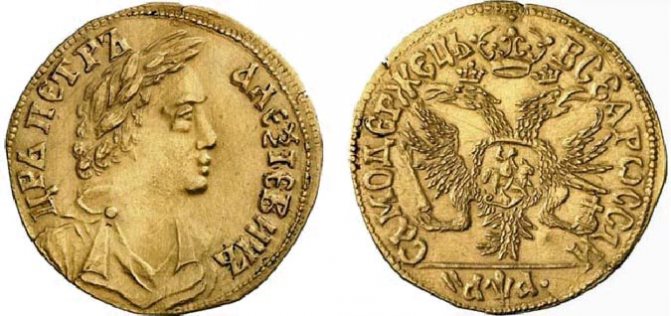
Gold coins of two chervonets were also issued, the weight of which reached almost seven grams. Subsequently, various gold coins were minted in the Russian Empire, and this happened until the outbreak of the First World War. At that time, paper credit notes were already in active circulation, which could be exchanged for real gold at any time. But in 1914 the government banned this exchange. Inflation grew in the country, and gold coins gradually disappeared from monetary circulation. The government did not confiscate them, people simply, seeing the situation in the country and the ban on the exchange of credit notes, began to accumulate gold money at home. So the coins turned into a real treasure.
The situation in the Russian Empire and in the world as a whole led to the fact that gold coins would eventually be abandoned in any case. Even before the outbreak of World War I, in 1910-1911, specialists from the Ministry of Finance and the Mint worked on a program to replace the composition of coins. Since the end of the 19th century, there was a shortage of pure gold, and there was no point in using it for coinage. In the future, the Ministry of Finance of the Russian Empire planned to completely replace gold in coins with bronze, and silver with nickel. In 1911, a small test batch of nickel coins was even made, and further plans were made to test a version with bronze.
But the monetary transformation was never destined to take place due to the subsequent war and revolution. The reform was carried out already during the period of Soviet rule. In the early years, the Soviet government still turned to minting gold coins. In October 1922, they decided to release a new gold piece called the “Sower.” The obverse of this ancient coin depicted a peasant sowing a field.
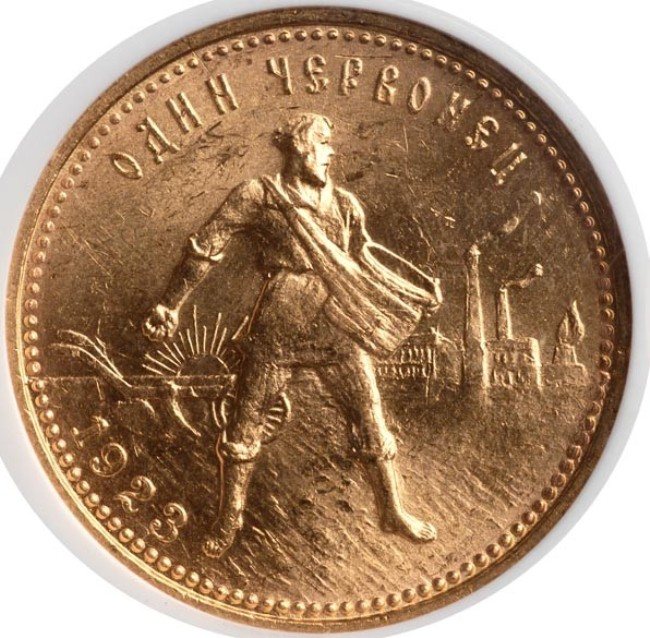
Apart from the difference in design, in other respects the Soviet gold chervonets completely copied the coin issued in the Russian Empire under Tsar Nicholas II. They were made from nine-hundredth standard gold, and each weighed exactly 8.6 grams. All Soviet “sowers” had the date: 1923. But already at the end of the 1920s, the Soviet leadership became convinced that minting coins from gold, silver and copper was a very expensive business, which was beyond the capabilities of a young state with a lagging economy.
The issue of gold money in the USSR ceased completely. Later, this tradition was resumed, but in the form of collectible and commemorative coins.
Golden chervonets “Sower”
It began production in 1923, about 100 thousand copies were minted. This banknote was produced again from 1975 to 1982. According to various estimates, the total circulation of the new Sower was about seven million.
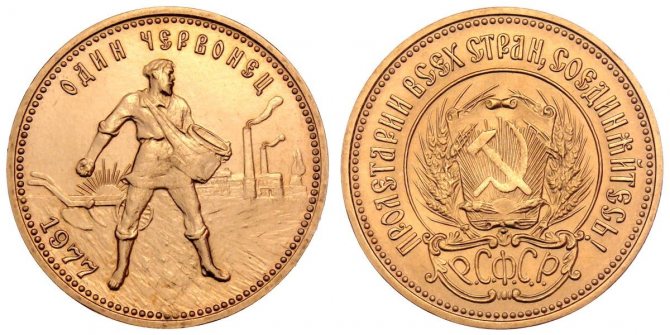
Gold in the product is nine hundredth standard. An additional advantage is that this coin has not been minted since 1982, so its purchase and sale price is higher than that of other investment pieces.
“Sower” is the most stable banknote, the value of which does not decrease even with fluctuations in the exchange rate of the metal on the market.
Golden "St. George the Victorious"
Issued by the Bank of Russia since 2006 in three versions:
- denomination 100 rubles, quality - proof, 10 thousand copies were minted in 2012;
- denomination - 50 rubles, proof quality, 10 thousand pieces were produced in 2012;
- denomination 50 rubles, uncirculated quality, continue to be produced, circulation has already amounted to more than 4.25 million pieces.

These coins weigh 0.25 ounces (7.78 g), which is great because it allows you to put smaller amounts into precious coin investments right away and build your portfolio over time.
It must be said that since 2009 the three-ruble “St. George the Victorious” has been minted, but it is made of silver. To date, about 1 million copies have been sold.
Gold money of English-speaking countries
In the United States of America, the history of minting its own gold coins started at the very end of the 18th century. Their first graduation took place there in 1795. First of all, the local mint began producing gold coins with unusual denominations of 10.5 and 2.5 dollars.
Subsequent US coin issues are associated with important events and names
| Denominations | Traces in history |
| In the States, they began minting gold money in one dollar and 20 dollar units. | This happened after the discovery of rich gold deposits in California and the subsequent “gold rush” (mid-19th century). |
| In 1853, another unusual gold coin came into circulation: a denomination of three dollars. | This non-standard amount was issued specifically for those who sent a lot of mail. The fact is that at that time one postage stamp cost 3 cents. For the convenience of purchasing it, a silver three-cent coin was specially created. But 3 gold dollars were intended to purchase a whole sheet of postage stamps, consisting of hundreds of stamps. |
| In 1907, the United States began minting twenty-dollar gold coins, nicknamed “Saint-Gaudens double eagles” for their appearance. | Saint-Gaudens is the architect who had a hand in the design of these gold coins. |
Such coins were made from gold of 900 standard, and each copy weighed 33.43 grams.
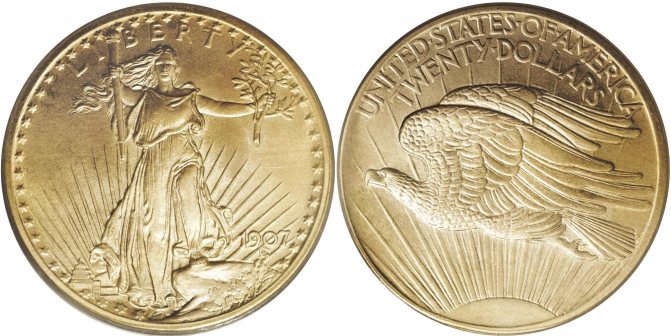
The cost of one such gold coin exceeded the monthly income of quite a few US residents at the beginning of the twentieth century. Therefore, “double eagles” immediately gained fame as a symbol of wealth and prosperity, because only a few lucky ones had such gold money in their wallets. Mass production of gold coins ceased in the States during the Great Depression (1929−1939) due to the difficult economic situation in the country.
In Great Britain, the first gold sovereigns - the most famous English money - were issued at the end of the 15th century, during the reign of King Henry VII. In 1489, a coin was produced, decorated with the image of a king sitting on a throne. Because of this design, this ancient coin was nicknamed the sovereign: from the word “sovereign,” which means “monarch, supreme ruler.” It weighed 15.5 grams, and its diameter reached 39.5 centimeters.
Its release was periodically stopped and then resumed again. In 1817, they began to produce it again, but in a smaller weight - about eight grams. The new design always features the profile of the current monarch on one side of the coin, and St. George spearing a serpent on the other.

During the First World War, due to the general difficult financial situation in the state, the issue of gold English sovereigns was stopped. It was subsequently resumed in 1957, but for collection purposes. Queen Elizabeth II is a crowned centenarian, and therefore today there are four types of sovereigns with her profile. They differ in their portraits of Elizabeth, reflecting the different ages of the queen.
Despite the fact that gold sovereigns are considered collectible coins, you can pay with them if you wish, since by law they are accepted as a full-fledged currency.
Russian kingdom
Ugorsky and the shipbuilder of Ivan III
- Korabelnik is a coin (medal) of Ivan III Vasilyevich, issued during his joint reign with his son, Ivan Ivanovich. Based on the legend of the coin, which contains both of these names, it is possible to establish the approximate date of its minting - between 1471 and 1490. The coin is made in the likeness of the English Nobel[1]. The only copy is kept in the Hermitage.
- Ugric - modeled on Hungarian ducats[2]. “Ugric” meant “Hungarian”[3] and differed from the modern meaning of the word (now the Mansi and Khanty are also classified as Ugrians[4]).
Ugric ducat of Ivan III (1477-8)
Shipbuilder of Ivan III (1471-1490)
False Dmitry I
“Wedding” gold in 10 Ugric (Portuguese) of False Dmitry I (1606, Hermitage)
The impostor also issued “Ugric” coins[2].
Shuisky
During the reign of Vasily Shuisky, gold “Novgorodki” and “Moskovski” (kopecks and dengi) were issued into circulation[2].
Romanovs
Under the Romanovs, from Mikhail to Peter, gold coins were minted - chervonets, half-chervonets and quarter-chervonetsy[2].
European antique gold money
Spain is famous for its rich history, where the first gold coins appeared in the 12th century, when Arab influence was strong in this territory. The first Spanish gold coin was called “maravedi”, it copied the Arabic dinar. Maravedis weighed four grams, of which three and a half were pure gold.
After the Arabs were expelled from the Iberian Peninsula, and Spain gained political and military weight in the world, annexing colonies in the New World (the ancient name of America), new money began to be minted from the gold brought from there. In 1535, the first gold escudos made of 917 gold were issued in Barcelona. One coin weighed four grams, and it contained three grams of pure gold. The obverse was decorated with a coat of arms, and on the reverse there was a Christian cross.
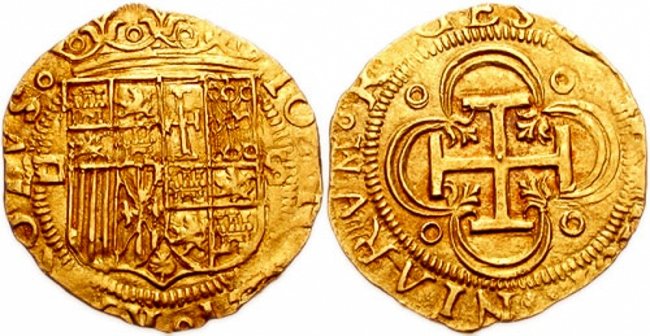
The first king of Spain, Philip II, contributed to the active circulation of gold escudos and their establishment as the main gold coins. But already in 1864, the cheaper silver escudo began to play the role of the main monetary unit of Spain. In 1876, new gold coins of 20 and 25 pesetas were launched into mass circulation. And in 1897, they also began to produce a hundred pesetas in one coin. But in 1904, the production of all gold and silver money in Spain was stopped, and since then only limited collectible quantities have been minted.
In Germany and Austria, until 1914, gold coins in denominations of ten and twenty marks were actively used. The last such coins were minted in 1916 in the city of Württemberg. They were created from nine-hundredth standard gold. They were dedicated to the anniversary of Kaiser Wilhelm II, the last German Emperor and King of Prussia, who reigned from 1888 to 1918. But these ancient coins were intended for collection, not mass distribution.
The most famous ancient gold coin issued in France has two names among the people:
- "Marianne";
- "rooster".
This is what the gold coins of ten and twenty francs are called. They received the name “Marianna” because of the girl depicted on one of the sides of the coin. The image of the beautiful Marianne appeared during the Great French Revolution. It symbolizes freedom.
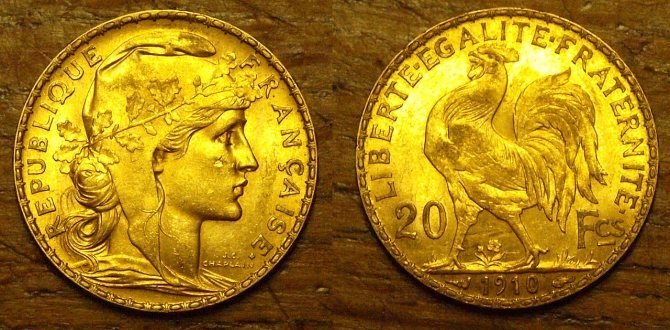
On the other side of the ancient coin there is a rooster, the symbol of France. Therefore, the second popular name for this gold money is “rooster”. On the reverse side of the coin, its denomination is also indicated and the words “liberte, egalite, fraternite” (freedom, equality, fraternity) are embossed. Their minting began in 1898 and ceased at the outbreak of the First World War in 1914.
Another ancient French gold coin popular among numismatists is popularly called the “genius”.
She was the predecessor of the "rooster". Gold twenty-franc coins were issued for a short period from 1818 to 1849 and again from 1871 to 1898. After this, they were replaced by the gold "rooster". But the “genius” continued to exist in coins of 50 and 100 francs. They began to be minted in 1878 and ceased production in 1914.
